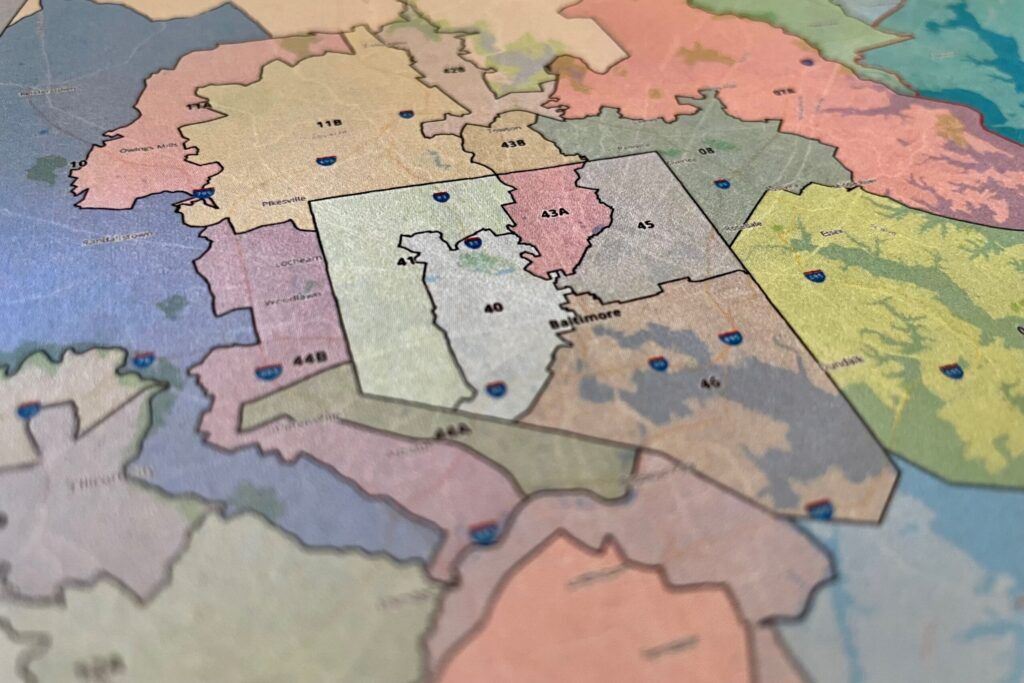
This content was republished with permission from WTOP’s news partners at Maryland Matters. Sign up for Maryland Matters’ free email subscription today.
Opponents of Maryland’s legislative redistricting plan filed challenges on Friday to a high court adviser’s recommendation to keep the boundaries drawn by the General Assembly.
Special Magistrate Alan M. Wilner, a former Court of Appeals Judge, said in a Monday report that the legislative maps should stand. Four petitions were filed objecting to that map, which was enacted by lawmakers in January.
All of the petitions argue that the legislative map violates the Maryland Constitution’s requirement that legislative districts be compact and respect natural and political boundaries.
Fair Maps Maryland, an anti-gerrymandering group with ties to Gov. Lawrence J. Hogan Jr. (R), announced a challenge to Wilner’s report Friday. The group is supporting a petition brought by Delegates Mark N. Fisher (R-Calvert), Nicholaus R. Kipke (R-Anne Arundel) and Kathy Szeliga (R-Baltimore County), who contend that several districts — 12, 21, 22, 23, 24, 27, 33 and 47 — violate the state constitution’s compactness requirements.
Wilner concluded that the Court of Appeals should reject those claims, writing that compactness is an “important element” but not the only factor when drawing up maps.
In a Friday filing, Strider Dickson, an attorney for the three Republican delegates, said Wilner had erred in his report. Dickson said the petitioners had presented “compelling evidence” that the districts aren’t compact.
Dickson also wrote that the report “wholly ignored” the challenges to District 27’s cross over the Patuxent River in an area without a bridge. And Dickson also said that Wilner erred in finding that legislative privilege prevented plaintiffs from conducting discovery as to why the districts were drawn they way they are.
The petitioners want the Court of Appeals to sustain their exceptions to Wilner’s report, find that the challenged districts violate the state constitution and that legislative privilege doesn’t bar them from conducting discovery on the drawing of the districts.
The state legislative map enacted by lawmakers earlier this year largely mirrors previous districts and could shore up several potentially vulnerable Democratic lawmakers.
Fair Maps Maryland spokesperson Doug Mayer, a former communications strategist for Hogan, contended in a release that the districts were drawn for partisan gain.
“This map was created with one single purpose in mind — to protect incumbents and the veto-proof majority by any means necessary, including blatant voter suppression and the violation of Marylanders’ civil rights,” Mayer said. “Judge Wilner wasn’t interested in righting these obvious wrongs but fortunately for Marylanders, he doesn’t have the final say on the matter. The Maryland Court of Appeals does, and we eagerly anticipate their ruling.”
On Wednesday, the court is expected to hear arguments in the case. The state’s deadline to respond to the challengers is Monday at 4:30 p.m.
Other challengers push back
Also on Friday, Dels. Brenda J. Thiam (R-Washington) and Wayne A. Hartman (R-Wicomico) and Hampstead resident Patricia Shoemaker (the wife of House Minority Whip Haven Shoemaker) challenged Wilner’s recommended denial of their petition. Their petition contends that the use of both single- and multi-member delegate districts, though part of the Maryland Constitution, conflicts with other constitutional provisions.
David K. Bowersox, their attorney, argued during a March trial that Maryland’s use of both single- and multi-member districts conflicts with the Maryland Declaration of Rights’ guarantee that elections be “free” and offer equal protection under law.
“This is not equal,” Bowersox said. “Three to one isn’t even close.”
Wilner noted in his report that the petitioners raised questions about voting equality, and said the issue is “a fair one that deserves attention,” but wrote that the issue should be left for the next redistricting cycle.
“The problem is one of time,” he wrote. “To strike down a provision of the Maryland Constitution … that has been an integral part of our redistricting law for 50 years, with a general election on our doorstep and a legislative session about to end, can create as much mischief as it resolves. The entire legislative redistricting plan would need to be reviewed and much of it rewritten.”
In response to Wilner’s report, Bowersox wrote that the petitioners “emphatically disagree” that time is a problem, and warned against delaying the issue until the next redistricting cycle.
“Petitioners do not agree that preparing a new redistricting plan will be the herculean task which the report fears,” Bowersox wrote. “Some effort will no doubt be involved.”
Bowersox added that the petitioners agree with Wilner’s assertion that “the issue has been raised, and it is a fair one that deserves attention” as to the issue of single- and multi-member districts. However, Bowersox also said the petitioners only want the map enacted by lawmakers tossed out and didn’t specifically request a constitutional change as relief.
Washington County Republican Central Committee President Seth Wilson, who filed a petition arguing that District 2’s cross from Western Maryland into Frederick County violates the state constitution, also filed an response to Wilner’s report. Wilson argued at a hearing that District 2 disregards county lines “for no good reason,” although Assistant Attorney General Andrea Trento argued that, with Western Maryland counties losing population, an eastward shift in Districts 1 and 2 was necessary.
In his report, Wilner wrote that there is no legal barrier to crossing county boundaries, particularly when its needed to ensure districts of roughly equal population.
The challenges to the case are being closely watched in Annapolis, with Wednesday’s hearing scheduled just two days before an already-delayed candidate filing deadline next Friday.







